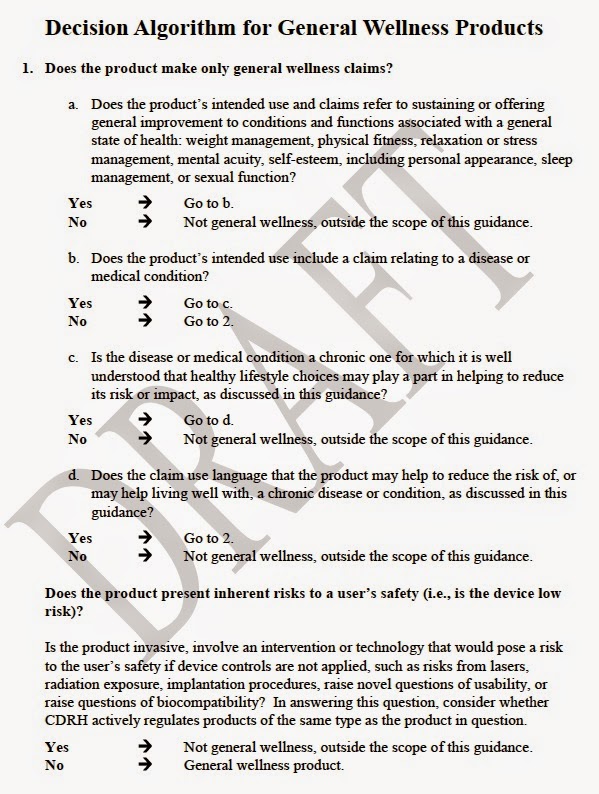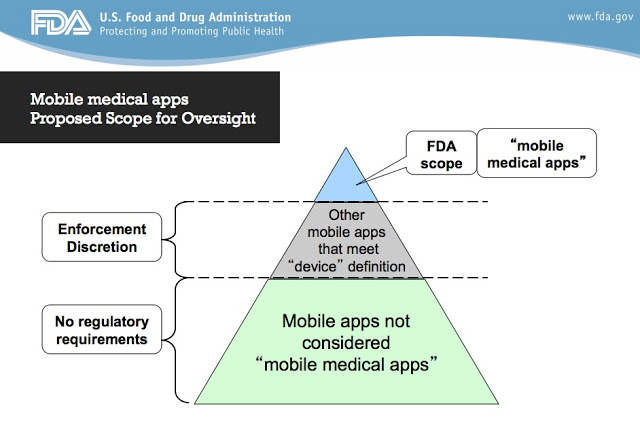“CDRH [FDA’s Center for Devices and Radiological Health] does not intend to examine low risk general wellness products to determine whether they are devices within the meaning of the FD&C Act,” says a new guidance posted today on the FDA website (“General Wellness: Policy for Low Risk Devices. Draft Guidance for Industry and Food and Drug Administration Staff“).
Recall FDA’s “Mobile medical apps Proposed Scope for Oversight” pyramid:
There are three parts of the pyramid:
- The top of the pyramid includes mobile medical apps that are traditional medical devices or a part or an extension of a traditional medical device. Clearly within the scope of being regulated as medical devices.
- The middle section includes patient self- management apps and simple tracking or trending apps not intended for treating/adjusting medication. This is the area, as defined by CDRH, for enforcement discretion
- The bottom section are devices that are not deemed “mobile medical apps” and, as such, have no regulatory requirements.
The guidance released today is an attempt to define the boundary between parts 2 and 3 of the pyramid and to clarify what FDA meant in a 2012 guidance when it said this:
“Mobile apps that are solely used to log, record, track, evaluate, or make decisions or suggestions related to developing or maintaining general health and wellness. Such decisions, suggestions, or recommendations are not intended for curing, treating, seeking treatment for mitigating, or diagnosing a specific disease, disorder, patient state, or any specific, identifiable health condition. Examples of these apps include dietary tracking logs, appointment reminders, dietary suggestions based on a calorie counter, posture suggestions, exercise suggestions, or similar decision tools that generally relate to a healthy lifestyle and wellness” (see “FDA Mobile Regulatory Fear Mongering by PhRMA“).
The last page of the guidance document is a “Decision Algorithm for General Wellness Products”:
 |
| Click on image for an enlarged view. |
Note: There is no “2.” in the algorithm, but I assume it’s the last paragraph. In any case, the examples cited by the FDA may better illustrate FDA’s thinking. Three out of 4 of these examples involve mobile apps:
Illustrative Example 1: A mobile application plays music to “soothe and relax” an individual and to “manage stress.”
These claims relate only to relaxation or stress management, not to any disease or medical condition, and thus are general wellness claims. In addition, the technology to play music does not present inherent risks to a user’s safety. Therefore, this product meets both criteria for a low risk general wellness product.
Illustrative Example 2: A mobile application that solely monitors and records daily energy expenditure and cardiovascular workout activities to “allow awareness of one’s exercise activities to improve or maintain good cardiovascular health.”
This claim relates to a specific organ only in the context of general health and does not refer to a disease or medical condition. In addition, to the extent the monitoring or recording exercise activities present risks (such as inaccuracy), when made in the absence of disease or medical condition claims, the risks to the user’s safety are low. Therefore, this product meets both criteria for a low risk general wellness product.
Illustrative Example 3: A mobile application monitors and records food consumption to “manage dietary activity for weight management and alert the user, healthcare provider, or family member of unhealthy dietary activity”.
This claim relates to dietary choices and weight management, and thus is a general wellness claim. In addition, the technology for monitoring or recording food consumption poses a low risk to the user’s safety. Therefore, this product meets both criteria for a low risk general wellness product.
It should be noted that these are the types of mobile health apps that an IMS Health assessment found to have “both limited and simple functionality” (see here). And these are the type of apps that pharma has a habit of publishing with very poor download results.
Next week, I will be presenting at the Social Media in the Pharmaceutical Industry conference in London. The title of my presentation is “The Sorry State of Pharma Mobile Health Apps and What to Do About It.” That presentation is embedded below:









![6 Digital Tools at the Center of Healthcare Digitalization [INFOGRAPHIC]](http://ec2-54-175-84-28.compute-1.amazonaws.com/pharma-mkting.com/wp-content/uploads/2021/04/6DigitalTools_600px-100x70.jpg)




